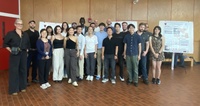Abstract:
Tongue weakness, like all weakness in Duchenne muscular dystrophy (DMD), occurs as a result of contraction-induced muscle damage and deficient muscular repair. Although membrane fragility is known to potentiate injury in DMD, whether muscle stem cells are implicated in deficient muscular repair remains unclear. We hypothesized that DMD myoblasts are less sensitive to cues in the extracellular matrix designed to potentiate structure–function relationships of healthy muscle. To test this hypothesis, we drew inspiration from the tongue and engineered contractile human muscle tissues on thin films. On this platform, DMD myoblasts formed fewer and smaller myotubes and exhibited impaired polarization of the cell nucleus and contractile cytoskeleton when compared with healthy cells. These structural aberrations were reflected in their functional behavior, as engineered tongues from DMD myoblasts failed to achieve the same contractile strength as healthy tongue structures. These data suggest that dystrophic muscle may fail to organize with respect to extracellular cues necessary to potentiate adaptive growth and remodeling.
